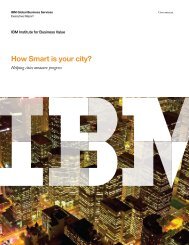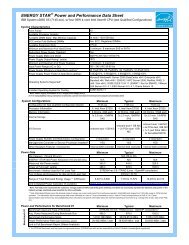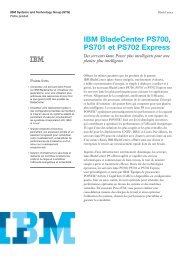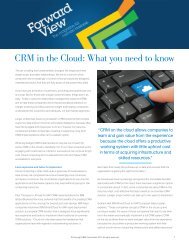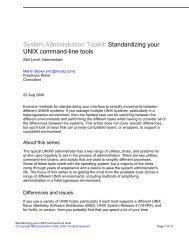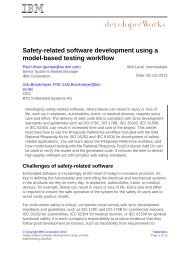Improving business through smart energy and environment ... - IBM
Improving business through smart energy and environment ... - IBM
Improving business through smart energy and environment ... - IBM
You also want an ePaper? Increase the reach of your titles
YUMPU automatically turns print PDFs into web optimized ePapers that Google loves.
February 2009<br />
<strong>Improving</strong> <strong>business</strong> <strong>through</strong> <strong>smart</strong> <strong>energy</strong><br />
<strong>and</strong> <strong>environment</strong> policy<br />
Businesses <strong>and</strong> public entities today face increasing pressure to develop policies that<br />
are both good for the planet <strong>and</strong> good for <strong>business</strong>. A framework developed by<br />
<strong>IBM</strong> offers <strong>business</strong>es <strong>and</strong> other organizations a comprehensive approach to <strong>energy</strong><br />
<strong>and</strong> <strong>environment</strong>al issues. The framework helps identify <strong>and</strong> prioritize <strong>environment</strong>al<br />
efforts by breaking down problems <strong>and</strong> opportunities into seven distinct <strong>business</strong><br />
areas, which can then be segmented into manageable projects.<br />
The pressure to “go green”<br />
As global warming heats up the planet, as the price of<br />
gas <strong>and</strong> electricity soars, as a global water shortage<br />
looms, the world has begun to underst<strong>and</strong> the need for<br />
<strong>energy</strong> conservation <strong>and</strong> <strong>environment</strong>al stewardship. This<br />
<strong>environment</strong>al concern has now hit the corporate mainstream.<br />
Companies are operating in a new regulatory <strong>environment</strong>,<br />
one that sets more stringent controls over <strong>energy</strong><br />
<strong>and</strong> water consumption, greenhouse gas emissions, the<br />
use of hazardous substances <strong>and</strong> the disposal of both<br />
st<strong>and</strong>ard <strong>and</strong> hazardous waste. Many <strong>business</strong>es find their<br />
stakeholders—investors, employees <strong>and</strong> customers—<br />
dem<strong>and</strong>ing corporate <strong>environment</strong>al responsibility.<br />
Additional pressure comes from the media <strong>and</strong> <strong>environment</strong>al<br />
advocacy groups.<br />
Environmental opportunities <strong>and</strong> challenges<br />
Executives interviewed for the <strong>IBM</strong> 2008 Global CEO<br />
Study report that their concern about <strong>environment</strong>al<br />
issues has doubled over the past four years, a concern<br />
that is filtering to CIOs <strong>and</strong> line of <strong>business</strong> leaders. These<br />
professionals are now being asked to quantify <strong>and</strong> reduce<br />
corporate <strong>energy</strong> use <strong>and</strong> <strong>environment</strong>al footprints, meet<br />
regulatory requirements related to the reduction of greenhouse<br />
gases, <strong>and</strong> modify IT departments to drive more<br />
<strong>energy</strong>-efficient operations.<br />
These activities are not merely <strong>environment</strong>ally responsible:<br />
they can also drive <strong>business</strong> opportunity. According to the<br />
Global CEO Study, chief executives believe that <strong>energy</strong><br />
<strong>and</strong> <strong>environment</strong>al activities can help differentiate their<br />
br<strong>and</strong>s <strong>and</strong> burnish the reputation of their products <strong>and</strong><br />
services. Enhanced br<strong>and</strong> image can deliver market permission<br />
(allowing companies to enter new markets where<br />
<strong>environment</strong>al concerns may be paramount) <strong>and</strong> drive<br />
customer loyalty.<br />
But developing a <strong>smart</strong> <strong>energy</strong> <strong>and</strong> <strong>environment</strong>al policy is<br />
a complicated process. That’s why many companies have<br />
yet to develop any type of comprehensive policy. Those<br />
entities that do strive to craft overall <strong>energy</strong> <strong>and</strong> <strong>environment</strong>al<br />
stewardship plans often take siloed approaches to<br />
the issue. This means they concentrate on one or two<br />
specific problems without determining how <strong>business</strong> activities—overall<br />
operations, product lifecycle management, IT,<br />
property management <strong>and</strong> other factors—interrelate.<br />
An <strong>energy</strong> <strong>and</strong> <strong>environment</strong> framework<br />
<strong>IBM</strong> has developed a comprehensive approach to assisting<br />
clients with <strong>energy</strong> <strong>and</strong> <strong>environment</strong>al issues. This<br />
framework helps identify <strong>and</strong> prioritize <strong>environment</strong>al<br />
efforts by illustrating how problems <strong>and</strong> opportunities can



